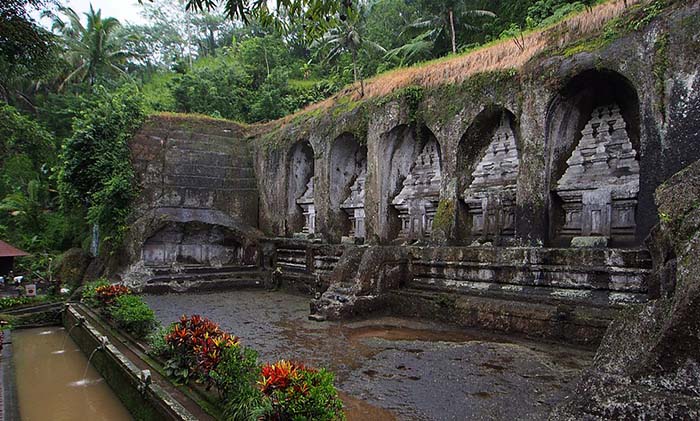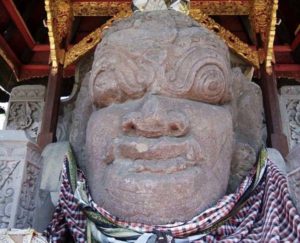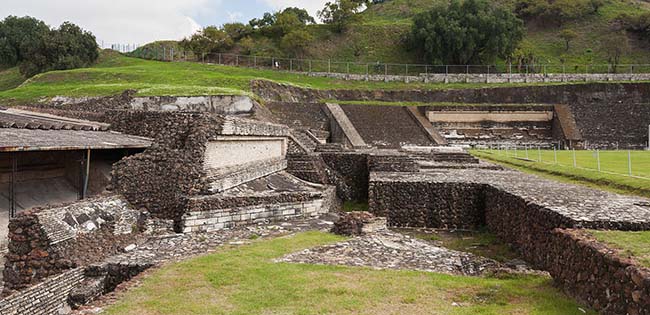
Long ago in Bali there lived a man named Arya Karang Buncing, whose marriage for years was not blessed with a child. So he went to the Bedugal Gaduh temple and asked the gods for their blessing. It worked. His wife became pregnant and gave birth to a boy. But he was not like other children. He ate lots and lots and grew bigger and bigger. When he was a teenager, he was so huge the villagers called him Kebo Iwa (Indonesian for buffalo).
He ate so much that one of his meals would feed 100 ordinary humans. His parents spent so much money to buy him food that they went bankrupt, so they asked the village to help give him food. In return, Kebo Iwa helped the village by building temples, digging wells, and protecting them from attackers.
But he was literally eating the village out of house and home. Their stores of food were nearly gone, so they told Kebo Iwa they could no longer feed him. In anger, he destroyed their temples. So the villagers came up with a plan. They told Kebo Iwa they would feed him again if he dug them a deep hole, which he did. Exhausted from the strenuous work, Kebo Iwa fell asleep at the bottom of the hole. The villagers siezed the opportunity. They filled in the hole, smothering him to death.
 A very old stone sculpture of Kebo Iwa’s enormous head can be seen at the Pura Gaduh temple in Blahbatuh.
A very old stone sculpture of Kebo Iwa’s enormous head can be seen at the Pura Gaduh temple in Blahbatuh.
But Kebo Iwa was a creator as well as a destroyer, and one of his most famous creations was the Gunung Kawi temple complex. According to legend, he carved the ten shrines out of the rock face in one night, using his fingernail.
Indonesian archaeologists have a different opinion. They say the rock-hewn shrines (in the photo at the top of this article) were build during the reign of King Anak in the 11th century (1080 AD). They are known as candis, named after Candika, consort of Lord Shiva, and Goddess of Death, and they are unique to the Hindus of Bali.
It is believed that when water flows over a candi it absorbs the essense of the resident deity and becomes holy. Even today, the Gunung Kawi complex is an important source for the holy water Balinese use in Hindu rites.
You Can Fill Your Bottle With Balinese Holy Water
Gunung Kawi is just one of the spiritual places you could visit in Bali as a member of the small group Body Mind Spirit Journeys is taking this September. This may be your best chance to visit to site created by the Balinese giant, Kebo Iwa.
Here are more of the highlights of our Spiritual and Beach Journey to the Paradise Island of the Gods…
- Visit a spiritual Monkey Forest
- Attend a dramatic sunset Kecak dance performance with flaming torches
- Bathe in the holy, healing waters of a 9th century temple
- Have a purification ceremony with a Balinese Priest
- Daily meditation sessions with tour leader, Pattie Weber
See all the September 26 – October 8 Bali tour details at THIS LINK.
The Aztecs Also Had Giants
Did Kebo Iwa have a relative on the other side of the world? According to Aztec traditions, there were seven giants who escaped the great flood and went on to create magnificent monuments. One of those giants was named Xelhua, and he is credited with building the biggest pyramid in the world, the Great Pyramid of Cholula.

Although its base is four times larger and volume is twice the size of the Great Pyramid of Giza, Egypt, the Cholula pyramid doesn’t appear as impressive because much of it remains hidden underneath a large hill near Pueblo, Mexico.
If you want to tell your friends you’ve been to the world’s biggest pyramid, and show them your Instagram pictures to prove it, then you’re in luck. Because there are still some spaces open on a Sacred Pyramid Tour of Mexico that includes Cholula.
Join this small group and you’ll also explore Aztec pyramids near Mexico City, Oaxaca and more. And you’ll be led by the tour host, Cliff Dunning from the Earth Ancients podcast. As a bonus, ancient mysteries expert Marco Vigato will take you around the mysterious pyramid complex at Teotihuacan.
See full details of the October 7 – 17 Mexico tour at THIS LINK.
Photo credits:
Gunung Kawi temple: rheins, CC BY 3.0, via Wikimedia Commons
Gran Pirámide de Cholula, Puebla, México: Diego Delso, CC BY-SA 3.0, via Wikimedia Commons